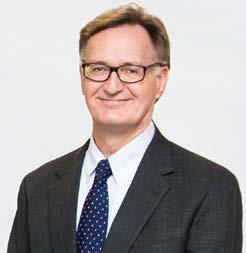
5 minute read
Legal Consult: New Covid-19 CMS Regulations: Harbingers Of The New Normal? Peter J. Martin, Esq
New Covid-19 CMS Regulations: Harbingers Of The New Normal?
Peter J. Martin, Esq.
On April 6, 2020, the Centers for Medicare and Medicaid Services issued an “Interim Final Rule” that is in many ways extraordinary. With very wide-ranging provisions spanning 16 different parts of Title 42 of the Code of Federal Regulations, CMS’s new rule dispenses with normal notice and comment rulemaking requirements in light of the current pandemic. Thus, this April 6 rule is effective March 31 and relates back to services rendered beginning March 1. In many cases, the new rule creates greater flexibility and reduced regulatory burdens for health care providers for the duration of the COVID-19 Public Health Emergency. As may be possible in other industries and professions now experiencing a “new normal” of distributed workforces and business processes, will the health care sector come to value these new flexibilities and freedoms as part of a post-pandemic regulatory environment?
Many of CMS’s new initiatives under the IFR are not mandated by the CARES Act but are focused on the Medicare program and consequent to the Secretary of Health and Human Services determination on January 31, 2020, that a public health emergency exists nationwide. CMS’s overall response to that emergency is to maximize the availability of existing health care resources to fight the pandemic, whether human or technical. A selection of the IFR’s new pandemic rules is described below. For example, beginning March 1, a broad array of new services may be provided through telehealth and various frequency requirements are being waived. The new telehealth services include nursing facility initial and discharge day visits; hospital admission and discharge day valuations and management visits; rest home, home health and intensive care evaluation and management visits; group psychotherapy; and physical and occupational therapy evaluations and re-evaluations. Likewise, some frequency requirements are lifted during the PHE: the limit on hospital care service through telehealth only once every three days and on nursing facility telehealth services only once every 30 days.
The provision of telehealth services only through “interactive telecommunications systems” is also being relaxed. The new rule clarifies that the exclusion of “smart” telephones from this category of systems is superseded. Also, with respect to opioid treatment, therapy and counseling can now be provided over the phone without the necessity of providing interactive twoway audio-visual communications. The Department of Health and Human Services’ Office of the Inspector General is waiving sanctions against providers for routinely waiving or reducing patient cost-sharing obligations for telehealth services. Finally, the HHS Office for Civil Rights, charged with enforcing the HIPAA data privacy and security rules, is exercising its enforcement discretion to waive penalties for HIPAA violations against providers who serve patients in good faith through such technologies as FaceTime and Skype.
Face-to-face diagnostic testing during a pandemic increases both the risk of infection of health care providers and the costs of protecting those providers from infection unless those services can be provided remotely. The new rule includes a significantly increased collection and associated travel allowance to clinical laboratories for specimen collection services for the duration of the pandemic. Likewise, remote physiological monitoring (such as blood pressure, weight, pulse oximetry and respiratory flow rate) is now payable under the clinical laboratory fee schedule for new, not just established, patients.
The IFR also addresses the increased demand on the physician workforce during the pandemic. Those increased demands may mean that a physician is not available to review a plan of care every 60 days for a home health Medicaid beneficiary. Thus, during the PHE, other types of “licensed practitioner of the healing arts acting within the scope of practice authorized under State law,” such as NPs and PAs, may write and review such plans.
Incident-to services under a physician’s direct supervision normally require the physician to be in the same location as the patient. Now, that supervision may be provided by “real-time interactive audio and video technology,” if indicated, to reduce exposure risks to the patient or provider. The rules do not establish the precise outlines of what technology is acceptable, however, and CMS is seeking comments on erecting “guardrails” regarding this change, which pertains not just to physician office services but also pulmonary, cardiac and intensive cardiac rehabilitation services.
Finally, the new rule contains provisions designed to ease the entry of residents into the pandemic fight. Normally, a resident counts for purposes of Indirect Medical Education and Direct Graduate Medical Education reimbursement purposes only if
they are providing patient care services within the scope of the approved residency program in a hospital, a doctor’s office or a clinic. Now, such residents under appropriate supervision may be counted for IME and DGME purposes if they are performing patient care duties within the scope of the program while in the resident’s home or in a patient’s home. Like the new rules pertaining to incident-to services, direct teaching physician supervision of residents (which usually requires the teaching physician to be present during the key portion of the service performed by the resident) may now be through the teaching physician’s “presence” via interactive telecommunications technology. This new flexibility does not extend to high-risk surgical, interventional or other complex procedures, endoscopic procedures or anesthesia services.
COVID-19 is forcing many businesses and professionals to re-think how they do work, and some may determine that what is now imposed on them by temporary circumstance should be adopted permanently as best practice. On a personal level, we may all get not only used to, but happy with, less-congested roads, less-polluted skies and more time with our loved ones. A number of the new initiatives summarized above may likewise become a popular part of a new way of providing health care. Practitioners may want to consider and weigh in on what innovations found in this IFR should be part of the “new normal.” As we emerge from this pandemic, one question posed by these new CMS regulations is whether we will come to see good, time-limited, pandemic policy as sound, permanent public policy.
Peter J. Martin, Esquire, is a partner at the Worcester office of Bowditch & Dewey, LLP, his practice concentrating on health care and nonprofit law.
Watch for our upcoming events Dates TBD













